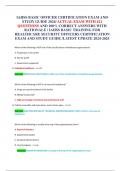Exam (elaborations)
Solutions Manual for South-Western Federal Taxation 2025, Corporations, Partnerships, Estates and Trusts 48th Edition By Annette Nellen, James Young, Brad Cripe, Sharon Lassar, Mark Persellin, Andrew Cuccia (All Chapters, 100% Original Verified, A+ Grade)
- Course
- Institution
This is Solutions Manual zip file forSouth-Western Federal Taxation 2025, Corporations, Partnerships, Estates and Trusts 48th Edition By Annette Nellen, James Young, Brad Cripe, Sharon Lassar, Mark Persellin, Andrew Cuccia (All Chapters, 100% Original Verified, A+ Grade). PDF file is giving error i...
[Show more]












